Detailed Evolution Characteristics of an Inclined Structure Hailstorm Observed by Polarimetric Radar over the South China Coast
Abstract
1. Introduction
2. Data and Methods
2.1. Observation Data
2.2. Data Processing of Dual-Polarization Radar
2.3. VDRAS
2.4. Improved Hydrometeor Identification Method Based on Polarization and Temperature
3. Case Overview
- From 08:00 to 20:00 LST on the 27th, the hail area was in a state of atmospheric stratification, with the upper layer being dry and the lower one being wet; the humidification of the lower layer was obvious at 20:00 LST. Low- and mid-level winds veered with a height and wind vector difference of 0–6 km, increasing from 16 m·s−1 to 26.6 m·s−1, indicating warm advection and moderate vertical wind shear typical of deep moist convection [56].
- At 20:00 LST on the 27th, the temperature difference between 850 and 500 hPa reached 27 °C, stronger than previous statistics of hailstorms in northern Guangdong, Guangdong Province, and the Pearl River Delta (PRD) (24–25 °C, [57]). The difference between the temperature and dew point was 46 °C, close to the upper limit of the average value (31.7–46.3 °C). There was also an inversion layer near 850 hPa.
- Regarding thermal conditions, the CIN decreased to 0 J/kg, the CAPE increased to 1183.30 J/kg, and the SI index was −1.15 °C at 20:00 LST. The heights of the wet bulb zero (WBZ) and the −20 °C were 3922 and 7997 m, respectively. At the same time, the CAPE value above the height of the −20 °C layer increased significantly. The above conditions are conducive to the rapid growth of hail in supercooled water areas and to the maintenance of ice crystal structure, both of which are conducive to the development and falling of hail.
4. Dual-Polarization Radar Fine-Structure Evolution Characteristics of the Hailstorm
4.1. Developments of the Hailstrom
- (1)
- From 08:00 to 16:00 LST on 27th, the wind direction below 6 km did not change significantly. The area within the 0–2.5 km altitude was occupied by southerly winds, with southwesterly winds prevailing at the middle and upper layers. Wind speed displayed an obvious increase from 12:00 to 16:00 LST. The wind speed below 0.5 km was about 10 m∙s−1 and was about 12 m∙s−1 at 0.5–2.5 km in height and 14–18 m∙s−1 above 2.5 km. The warm, moist southwesterly winds continuously conveyed from the South China Sea to the land, providing favorable thermal conditions for the development of subsequent storms.
- (2)
- The wind speed of the whole layer did not change much from 16:00 to 18:00 LST on the 27th, but the wind direction at the middle and high layers turned from southwesterly to westerly. This change was related to an eastward-moving short-wave trough, with Yangjiang City being located at the bottom of the trough.
- (3)
- From 18:00 LST on 27th to 00:00 LST on 28th, the westerly wind above 4 km angled to the northwest, with the wind speed undergoing a significant increase (16–22 m·s−1). At 2.0–4.0 km, the southwest wind changed to a westerly wind, with little change in the wind speed. The wind direction at the lower level did not change much, but the wind speed first decreased and then increased. At this stage, the wind rotated clockwise as it ascended, suggesting obvious warm advection currents conducive to storm development. A northwesterly air flow was dominant at the altitude above 4 km, correlating with the rapid southeastward movement of the storm.
4.2. Dual-Polarization Radar-Observed Structure of Hailing Stage
4.3. The Evolution of ZDR Column and KDP Column
5. Kinetic Properties Structure of the Inclined Hailstorm
6. Discussions and Conclusions
- (1)
- This event occurred in the overlapping area of the 200 hPa distributary area and lower-level shear line. The upper-level divergence and lower-level convergence provided favorable dynamic uplifts. Under this unstable stratification, the CIN decreased to 0 J/kg, the CAPE increased to 1183.30 J·kg−1, and the SI index was −1.15 °C at 20:00 LST. The heights of the wet bulb zero (WBZ) and −20 °C were 3.922 and 7.997 km, respectively. The wind vector difference of 0–6 km increased from 16 m∙s−1 to 26.6 m∙s−1. All environmental physical quantities were conducive to the occurrence of severe convective weather.
- (2)
- The ZDR arc, ZDR column, and KDP column were clearly observed from the initial stage to the mature stage of the hailstorm (19:00–21:48 LST). During this period, the ZDR column and KDP column increased gradually, while the CC kept decreasing. The ZDR column and KDP column reached their greatest heights (11.5 km and 8.5 km, respectively) during the hailfall stage (21:54–23:00 LST), and a CC valley appeared during this time. In particular, two vertical centers (C1, C2) with strong reflectivity appeared during this stage. C1 was located at 2–4 km, and C2 was located at 6–8 km. The maximum horizontal distance between C1 and C2 was 8 km. This implies that the hailstorm was strongly inclined and featured large hailstones.
- (3)
- It was found from the analysis of the hydrometeor classifications revealed by the improved HCA and the high-resolution VDRAS that the formation of the inclined structure was closely related to the airflow evolution. The updraft at the BWER on the front side of the hailstorm increased to 20 m∙s−1, which maintained C2 at a high level. An ice-phase process occurred within C2 when the large raindrops at the lower part of C2 were lifted to the vicinity of C2 by the updraft, gradually increasing hailstone size. A sloping downward trajectory was exhibited under the influences of divergent outflow at the higher layer (8 km), ambient horizontal winds and strong vertical wind shear, and weakened updrafts from the hailfall drag.
Author Contributions
Funding
Informed Consent Statement
Conflicts of Interest
References
- Zhang, X.J.; Tao, Y.; Liu, G.Q.; Peng, Y.X. Study on the evolution of hailstorm and its cloud physical characteristics. Meteorol. Mon. 2019, 45, 415–425. (In Chinese) [Google Scholar]
- Baldi, M.; Ciardini, V.; Dalu, J.D.; De Filippis, T.; Maracchi, G.; Dalu, G. Hail occurrence in Italy: Towards a national database and climatology. Atmos. Res. 2014, 138, 268–277. [Google Scholar] [CrossRef]
- Púčik, T.; Groenemeijer, P.; Rýva, D.; Kolář, M. Proximity Soundings of Severe and Nonsevere Thunderstorms in Central Europe. Mon. Weather Rev. 2015, 143, 4805–4821. [Google Scholar] [CrossRef]
- Raupach, T.H.; Martius, O.; Allen, J.T.; Kunz, M.; Lasher-Trapp, S.; Mohr, S.; Rasmussen, K.L.; Trapp, R.J.; Zhang, Q. The effects of climate change on hailstorms. Nat. Rev. Earth Environ. 2021, 2, 213–226. [Google Scholar] [CrossRef]
- Meng, Z.; Zhang, F.; Luo, D.; Tan, Z.; Fang, J.; Sun, J.; Shen, X.; Zhang, Y.; Wang, S.; Han, W.; et al. Review of Chinese atmospheric science research over the past 70 years: Synoptic meteorology. J. Sci. China Earth Sci. 2019, 62, 1946–1991. (In Chinese) [Google Scholar] [CrossRef]
- Li, H.; Zhang, D. High-Resolution Modeling of Convective Storms: Progress and Future Challenges. Adv. Meteorol. Sci. Technol. 2021, 11, 75–91. (In Chinese) [Google Scholar]
- Battern, L.J. Doppler radar observation of a hailstorm. Appl. Meteor. 1975, 14, 98–108. [Google Scholar]
- Miller, R.C. Notes on Analysis and Severe Storm Forecasting Procedures of the Air Force Global Weather Central; Technical Report 200 (Rev); Air Weather Service: Omaha, NE, USA, 1972; 181p. [Google Scholar]
- Hubbert, J.; Bringi, V. The effects of three-body scattering on differential reflflectivity signatures. J. Atmos. Ocean. Technol. 2000, 17, 51–61. [Google Scholar] [CrossRef]
- Browning, K.A.; Foote, G.B. Airflow and hail growth in supercellstorms and some implications for hail suppression. Quart. J. Roy. Meteor. Soc. 1976, 102, 499–533. [Google Scholar] [CrossRef]
- Gobbo, S.; Ghiraldini, A.; Dramis, A.; Dal Ferro, N.; Morari, F. Estimation of Hail Damage Using Crop Models and Remote Sensing. Remote Sens. 2021, 13, 2655. [Google Scholar] [CrossRef]
- Chalon, J.P.; Famkhauser, J.C.; Eccles, P.J. Structure of an Evolving Hailstorm, Part 1: General Characteristics and Cellular Structure. Mon. Weather Rev. 2009, 104, 564–575. [Google Scholar] [CrossRef]
- Browning, K.A.; Frankhauser, J.C.; Chalon, J.P.; Eccles, P.J.; Strauch, R.G.; Merrem, F.H.; Musil, D.J.; May, E.L.; Sand, W.R. Structure of an Evolving Hailstorm Part V: Synthesis and implications for Hail Growth and Hail Suppression. Mon. Weather Rev. 1976, 104, 603–610. [Google Scholar] [CrossRef]
- Xu, F.; Zheng, Y.Y.; Xiao, H.; Mu, X. Mesoscale Characteristics of a Severe Hail Event over the Area Along Yangtze River in Jiangsu. Meteorol Mon. 2016, 42, 567–577. (In Chinese) [Google Scholar]
- Park, H.S.; Ryzhkov, A.V.; Zrnić, D.S.; Kim, K.E. The hydrometeor classifification algorithm for the polarimetric WSR-88D: Description and application to an MCS. Weather Forecast. 2009, 24, 730–748. [Google Scholar] [CrossRef]
- Pan, J.W.; Wei, M.; Guo, L.J. Dual-polarization radar characteristic analysis of theevolution ofheavy hail supercell in Southern Fujian. J. Meteorol. Mon. 2020, 46, 1608–1620. (In Chinese) [Google Scholar]
- Carras, J.N.; Macklin, W.C. The shedding of accreted water during hailstone growth. Q. J. R. Meteorol. Soc. 1973, 99, 639–648. [Google Scholar] [CrossRef]
- Grant, L.D.; Van Den Heever, S.C. Microphysical and dynamical characteristics of low-precipitation and classic supercells. Atmos. Sci. 2014, 71, 2604–2624. [Google Scholar] [CrossRef]
- Knight, C.; Knight, N. The falling behavior of hailstones. J. Atmos. Sci. 1970, 27, 672–680. [Google Scholar] [CrossRef]
- Browning, K. Some inferences about the updraft within a severe local storm. Atmos. Sci. 1965, 22, 669–677. [Google Scholar] [CrossRef]
- Straka, J.; Zrnic, D. An algorithm to deduce hydrometeor types and contents from multiparameter radar data.C. In Proceedings of the 26th International Conference on Radar Meteorology, Norman, OK, USA, 24–28 May 1993; pp. 513–516. [Google Scholar]
- Straka, J. Hydrometeor fields in a supercell storm as deduced from dual-polarization radar. In Proceedings of the 18th Conference on Severe Local Storms, San Francisco, CA, USA, 19–23 February 1996; pp. 551–554. [Google Scholar]
- Liu, L.; Zhang, H.; Wang, Z. Preliminary Research for Method of Hail Detection with C Band Dual Linear Polarization Radar. J. Plateau Meteorol. 1993, 12, 333–337. (In Chinese) [Google Scholar]
- Zrnic, D.S.; Ryzhkov, A.; Strala, K. Testing a Procedure for Automatic Classification of Hydrometeor Types. J. Atmos. Ocean. Technol. 2001, 18, 892–913. [Google Scholar] [CrossRef]
- Cao, J.W.; Liu, L.P.; Ge, R.S. A study of fuzzy logic method in classification of hydrometeors base on polarimetric rada measurement. J. Chin. J. Atmos. Sci. 2005, 29, 827–836. (In Chinese) [Google Scholar]
- Picca, J.; Ryzhkov, A. A dual-wavelength polarimetric analysis of the 16 May 2010 Oklahoma City extreme hailstorm. Mon. Weather Rev. 2012, 140, 1385–1403. [Google Scholar] [CrossRef]
- Montopoli, M.; Picciotti, E.; Baldini, L.; Di Fabio, S.; Marzano, F.S.; Vulpiani, G. Gazing inside a giant-hail-bearing Mediterranean supercell by dual-polarization Doppler weather radar. Atmos. Res. 2021, 264, 105852. [Google Scholar] [CrossRef]
- Elmore, K.; Flamig, Z.; Lakshmanan, V.; Kaney, B.; Reeves, H.; Farmer, V.; Rothfusz, L. mPING: Crowd-sourcing weather reports for research. Bull. Am. Meteorol. Soc. 2014, 95, 1335–1342. [Google Scholar] [CrossRef]
- Schuur, T.J.; Park, H.S.; Ryzhkov, A.V.; Reeves, H.D. Classification of precipitation types during transitional winter weather using the RUC model and polarimetric radar retrievals. J. Appl. Meteorol. Climatol. 2012, 51, 763–779. [Google Scholar] [CrossRef]
- Wu, C.; Liu, L.; Wei, M.; Xi, B.; Yu, M. Statistics-based optimization of the polarimetric radar hydrometeor classification algorithm and its application for a squall line in South China. Adv. Atmos. Sci. 2018, 35, 296–316. [Google Scholar] [CrossRef]
- Liu, X.; Wan, Q.; Wang, H.; Xiao, H.; Zhang, Y.; Zheng, T.; Feng, L. Raindrop Size Distribution Parameters Retrieved from Guangzhou S-band Polarimetric Radar Observations. J. Meteorol Res. 2018, 32, 571–583. [Google Scholar] [CrossRef]
- Li, H.; Wan, Q.; Peng, D.; Liu, X.; Xiao, H. Multiscale analysis of a record-breaking heavy rainfall event in Guangdong, China. Atmos. Res. 2020, 232, 104703. [Google Scholar] [CrossRef]
- Sun, J.; Crook, N.A. Dynamical and Microphysical Retrieval from Doppler Radar Observations Using a Cloud Model and Its Adjoint. Part I: Model Development and Simulated Data Experiments. J. Atmos. Sci. 1997, 54, 1642–1661. [Google Scholar] [CrossRef]
- Sun, J.Z.; Crook, N.A. Dynamical and microphysical retrieval from Doppler radar observations using a cloud model and its adjoint. Part II: Retrieval experiments of an observed Florida convective storm. J. Atmos. Sci. 1998, 55, 835–852. [Google Scholar] [CrossRef]
- Sun, J.; Zhang, Y. Analysis and prediction of a squall line observed during IHOP using multiple WSR-88Dobservations. Mon. Weather Rev. 2008, 136, 2364–2388. [Google Scholar] [CrossRef]
- Sun, J.; Chen, M.; Wang, Y. A frequent-updating analysis system based on radar, surface, and mesoscale model data for the Beijing 2008 forecast demonstration project. Weather Forecast 2010, 25, 1715–1735. [Google Scholar] [CrossRef]
- Zhou, A.; Zhao, K.; Lee, W.-C.; Huang, H.; Hu, D.; Fu, P. VDRAS and polarimetric radar investigation of a bow echo formation after a squall line merged with a preline convective cell. J. Geophys. Res. Atmos. 2020, 125, e2019JD031719. [Google Scholar] [CrossRef]
- Rao, X.; Zhao, K.; Chen, X.; Huang, A.; Hu, S.; Hu, D.; Liu, X. Roles of multi-scale orography in triggering nocturnal convection at a summer rainfall hotspot over the South China coast: A case study. J. Geophys. Res. Atmos. 2022, 127, e2022JD036503. [Google Scholar] [CrossRef]
- Zhuang, Z.R.; Xue, S.; Shen, X.S.; Li, X.L. Implementation of CMA-GFS 3D-Var System on the Yin-Yang Grid. J. Trop. Meteorol. 2021, 27, 346–354. [Google Scholar]
- Stipanuk, G.S. Algorithms for Generating a Skew-T,log p Diagram and Computing Selected Meteorological Quantities; T.Army Electronics Command Fort: Monmouth, NJ, USA, 1974. [Google Scholar]
- Cui, X.; Gu, H.; Cao, Y. Simplification of Barometric Height Formula in Geopotential Height Calculation and Resulted Errors. Meteorol. Sci. Technol. 2017, 45, 307–312. (In Chinese) [Google Scholar] [CrossRef]
- Crum, T.D.; Alberty, R.L.; Burgess, D.W. Recording, Archiving, and Using WSR-88D Data. Bull. Am. Meteorol. Soc. 1993, 74, 645–788. [Google Scholar] [CrossRef]
- Guo, Z.; Hu, S.; Liu, X.; Chen, X.; Zhang, H.; Qi, T.; Zeng, G. Improving S-Band Polarimetric Radar Monsoon Rainfall Estimation with Two-Dimensional Video Disdrometer Observations in South China. Atmosphere 2021, 12, 831. [Google Scholar] [CrossRef]
- Giangrande, S.E.; Mcgraw, R.; Lei, L. An application of linear programming to polarimetric radar differential phase processing. J. Atmos. Ocean. Technol. 2013, 30, 1716–1729. [Google Scholar] [CrossRef]
- Chen, G.; Zhao, K.; Zhang, G.; Huang, H.; Liu, S.; Wen, L.; Yang, Z.L.; Yang, Z.W.; Xu, L.; Zhu, W. Improving polarimetric c–band radar rainfall estimation with two–dimensional video disdrometer observations in eastern China. Hydrometeorology 2017, 18, 1375–1391. [Google Scholar] [CrossRef]
- Huang, H.; Zhang, G.; Zhao, K.; Giangrande, S.E. A Hybrid Method to Estimate Specific Differential Phase and Rainfall with Linear Programming and Physics Constraints. IEEE Trans. Geosci. Remote Sens. 2016, 55, 96–111. [Google Scholar] [CrossRef]
- Guan, L.; Dai, J.; Xu, J.; Yin, C.G. Adaptive calculation of specific differential phase for S-band dual-polarimetric doppler radar. Torrential Rain Disasters. 2019, 38, 668–675. [Google Scholar]
- Chen, X.; Zhao, K.; Sun, J.; Zhou, B.; Lee, W.C. Assimilating surface observations in a four-dimensional variational Doppler radar data assimilation system to improve the analysis and forecast of a squall line case. Adv. Atmos. Sci. 2016, 33, 1106–1119. [Google Scholar] [CrossRef]
- Xiao, X.; Sun, J.; Chen, M.; Qie, X.; Ying, Z.; Wang, Y.; Ji, L. Comparison of environmental and mesoscale characteristics of two types of mountain-to-plain precipitation systems in the Beijing Region, China. J. Geophys. Res.-Atmos. 2019, 124, 6856–6872. [Google Scholar] [CrossRef]
- Xiao, X.; Sun, J.; Chen, M.; Qie, X.; Wang, Y.; Ying, Z. The characteristics of weakly forced mountain-to-plain precipitation systems based on radar observations and high-resolution reanalysis. J. Geophys. Res. Atmos. 2017, 122, 3193–3213. [Google Scholar] [CrossRef]
- Zhang, F.; Zhang, Q.; Sun, J. Initiation of an elevated mesoscale convective system with the influence of complex terrain during Meiyu season. J. Geophys. Res. Atmos. 2021, 126, e2020JD033416. [Google Scholar] [CrossRef]
- Skamarock, W.C.; Klemp, J.B. A time-split nonhydrostatic atmospheric model for weather research and forecasting applications. J. Comput. Phys. 2008, 227, 3465–3485. [Google Scholar] [CrossRef]
- Dolan, B.; Rutledge, S.A. A theory-based hydrometeoridentification algorithm for X-band polarimetric radars. J. Atmos. Oceanic Technol. 2009, 26, 2071–2088. [Google Scholar] [CrossRef]
- Dolan, B.; Rutledge, S.A.; Lim, S.; Chandrasekar, V.; Thurai, M. A Robust C-Band Hydrometeor Identification Algorithm and Application to a Long-Term Polarimetric Radar Dataset. J. Appl. Meteorol. Climatol. 2013, 52, 2162–2186. [Google Scholar] [CrossRef]
- Vivekanandan, J.; Zrnic, D.S.; Ellis, S.M.; Oye, R.; Ryzhkov, A.V.; Straka, J. Cloud microphysics retrieval using S-band dual-polarization radar measurements. Bull. Amer. Meteor. Soc. 1999, 80, 381–388. [Google Scholar] [CrossRef]
- Yu, X.D.; Zheng, Y.Y.; Zhang, A.M.; Yao, Y.Q.; Fang, C. The detection of a severe tornado event in anhui with china new generation weather radar. J. Plateau Meteorol. 2006, 25, 914–924. (In Chinese) [Google Scholar]
- Zeng, Z.; Chen, Y.; Zhu, K.; Li, S.Q. Characteristics of atmospheric stratification and melting effect of heavy hail events in Guangdong Province. Chin. J. Ofatmospheric Sci. 2019, 43, 598–617. (In Chinese) [Google Scholar]
- Kumjian, M.R.; Ryzhkov, A.V. Polarimetric signatures in supercell thunderstorms. J. Appl. Meteorol. Climatol. 2008, 47, 1940–1961. [Google Scholar] [CrossRef]
- Snyder, J.C.; Ryzhkov, A.V.; Kumjian, M.R.; Khain, A.P.; Picca, J. A ZDR column detection algorithm to examine convective storm updrafts. Weather Forecast 2015, 30, 1819–1844. [Google Scholar] [CrossRef]
- Wu, H.Y.; Zeng, M.J.; Mei, H.X.; Zhang, B. Study on Sensitivity of Wind Field Variation to Structure and Development of Convective Storms. J. Trop. Meteorol. 2020, 26, 57–70. [Google Scholar]
- Kumjian, M.R.; Ryzhkov, A.V.; Reeves, H.D.; Schuur, T.J. A Dual-polarization radar signature of hydrometeor refreezing in winter storms. J. Appl. Meteorol. Climatol. 2013, 52, 2549–2566. [Google Scholar] [CrossRef]
- Heinselman, P.L.; Ryzhkov, A.V. Validation of Polarimetric Hail Detection. Weather Forecast 2006, 21, 839–850. [Google Scholar] [CrossRef]
- Loney, M.L.; Zrnić, D.S.; Straka, J.M.; Ryzhkov, A.V. Enhanced polarimetric radar signatures above the melting level in a supercell storm. J. Appl. Meteorol. 2002, 41, 1179–1194. [Google Scholar] [CrossRef]
- Ryzhkov, A.V.; Kumjian, M.R.; Ganson, S.M.; Zhang, P. Polarimetric radar characteristics of melting hail. Part II: Practical implications. J. Appl. Meteorol. Climatol. 2013, 52, 2871–2886. [Google Scholar] [CrossRef]
- Mirkovic, D.; Zrnic, D.S.; Melnikov, V.; Zhang, P. Effects of Rough Hail Scattering on Polarimetric Variables. IEEE Trans. Geosci. Remote Sens. 2021, 60, 1–14. [Google Scholar] [CrossRef]

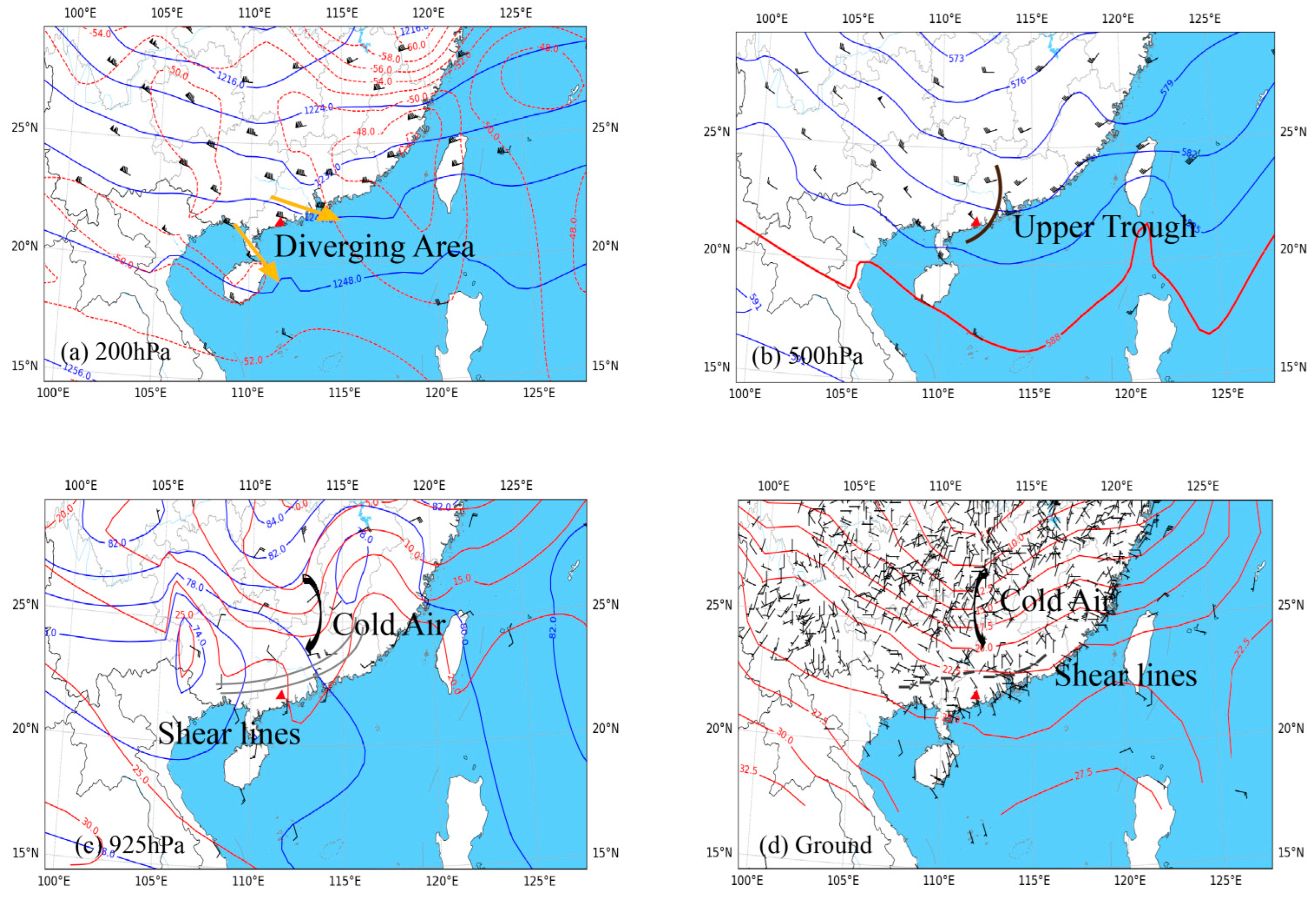
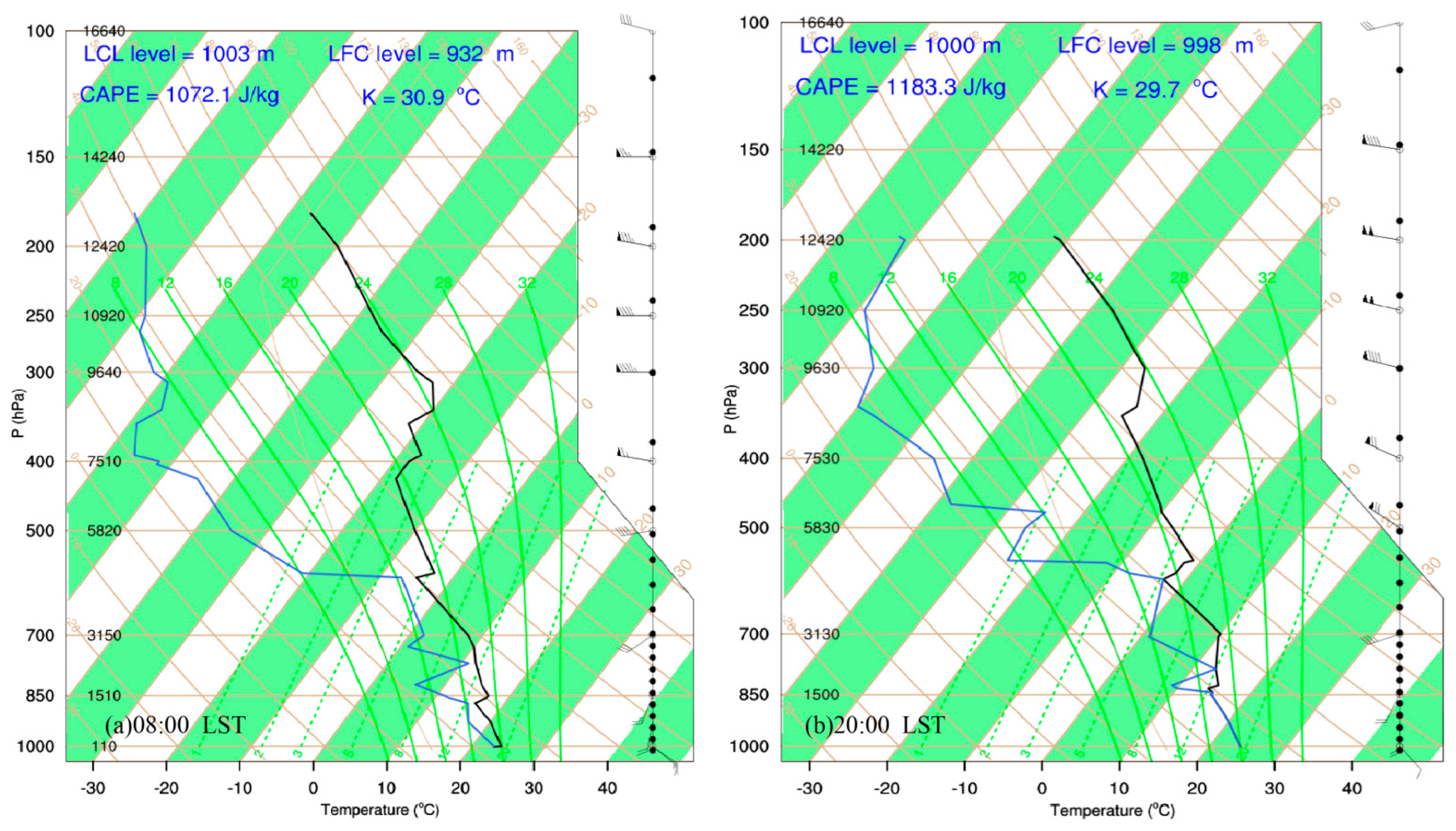

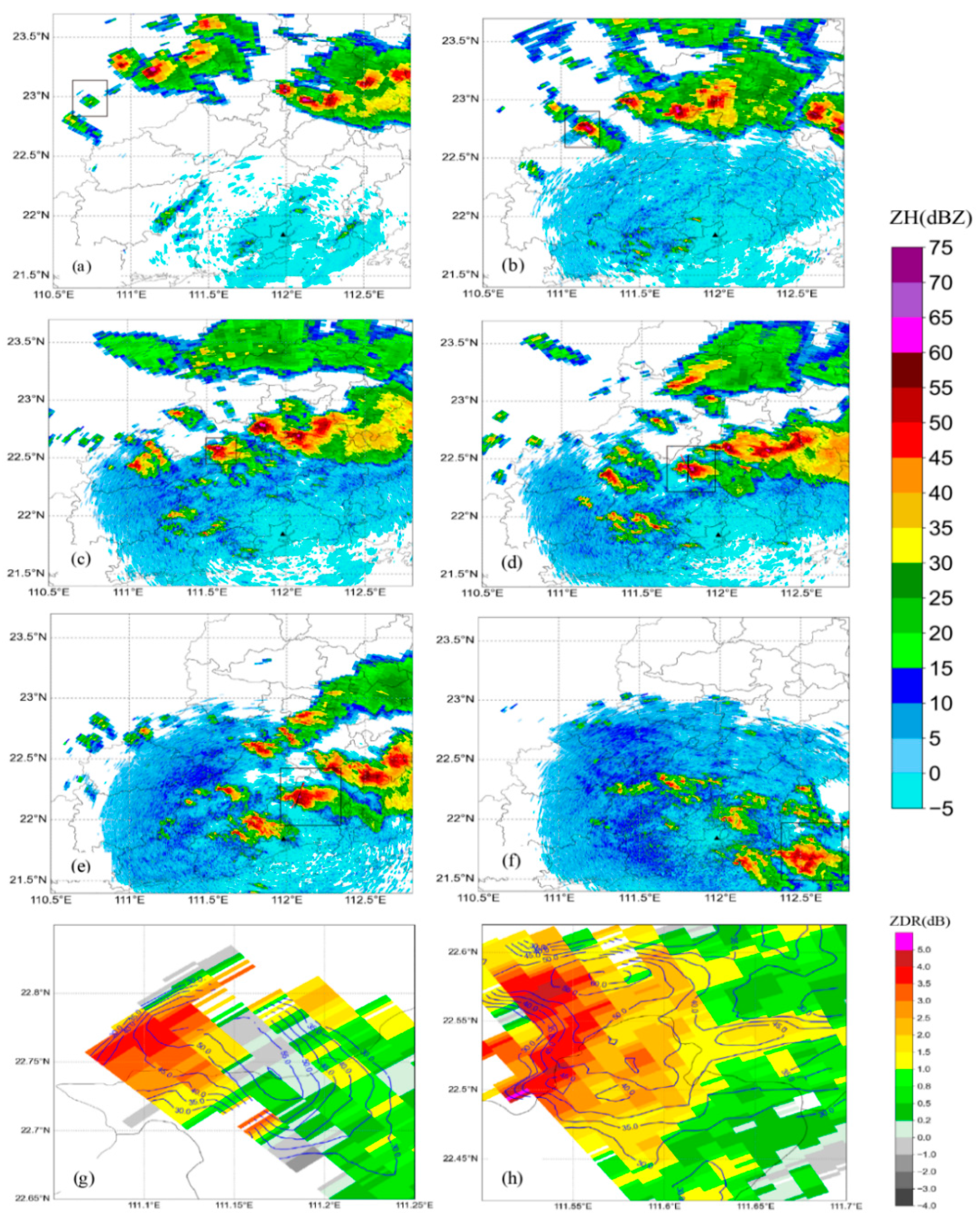
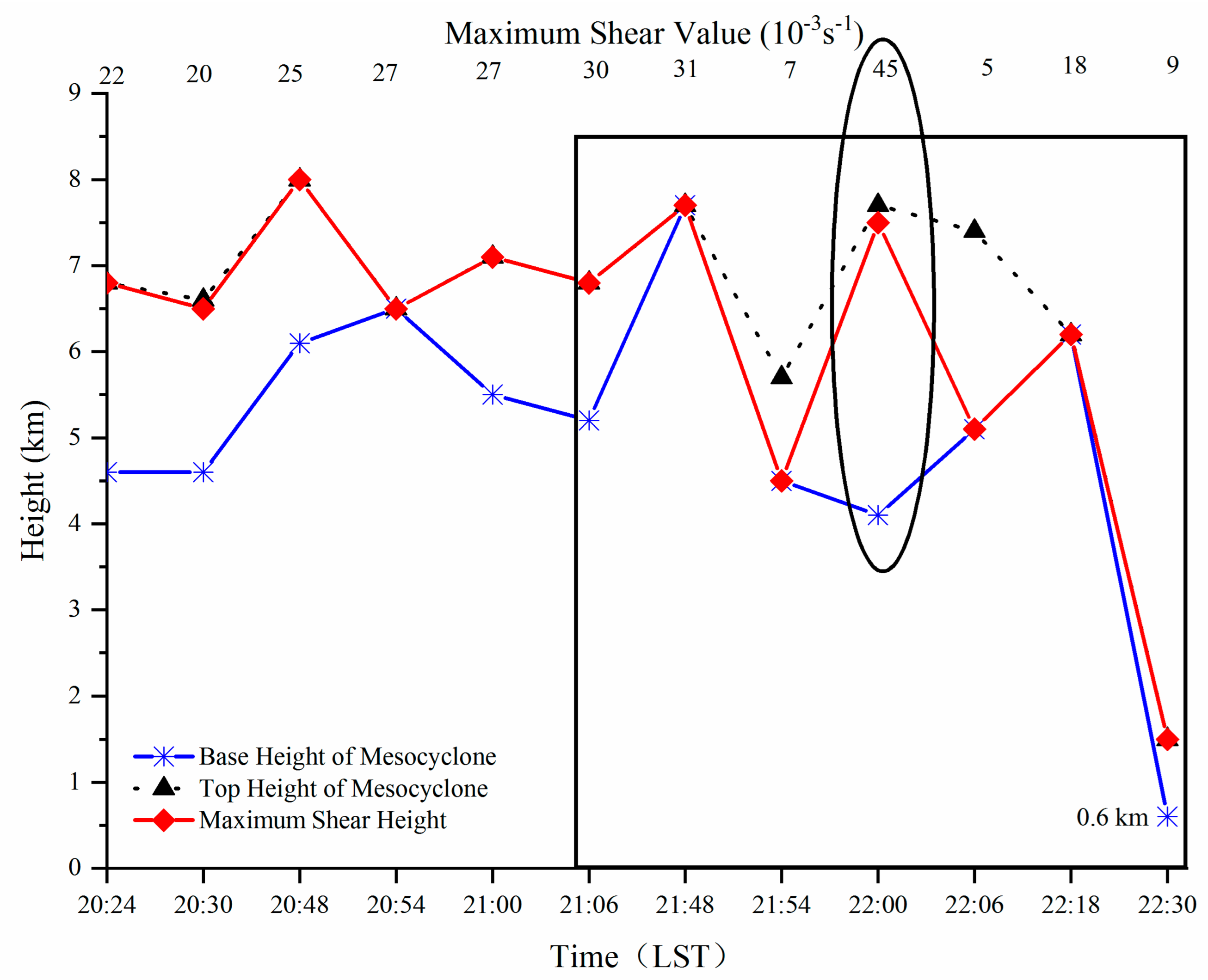
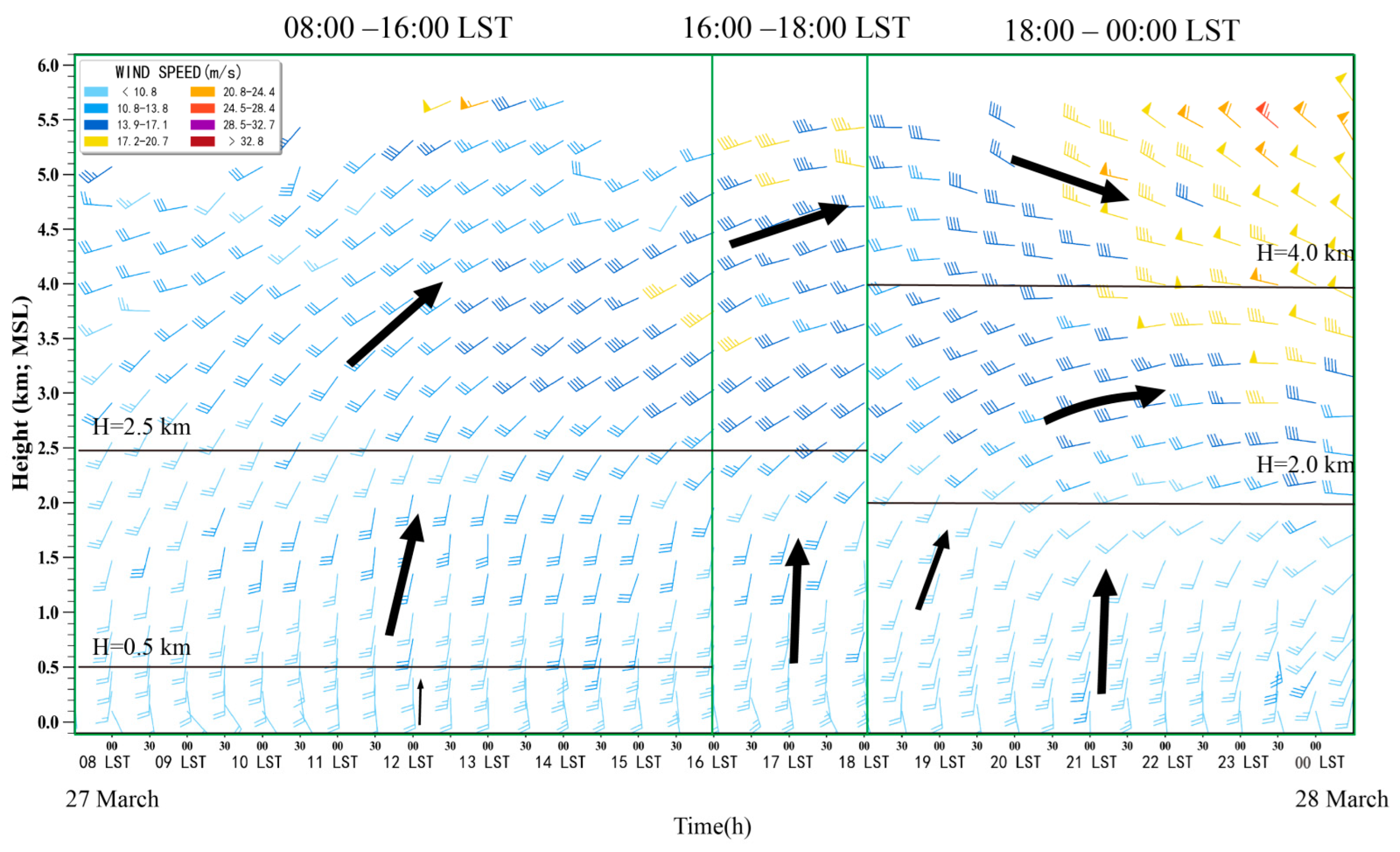
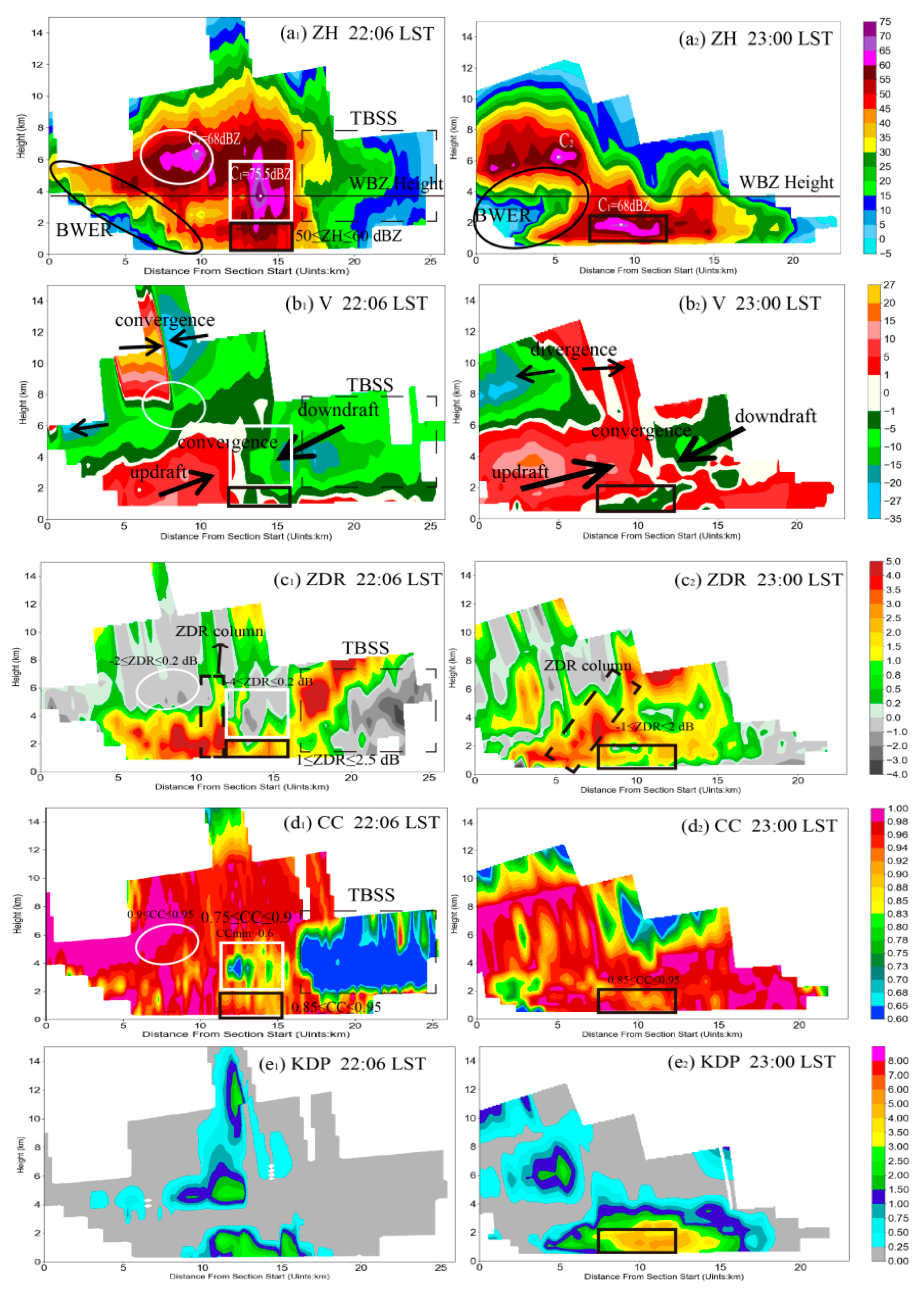
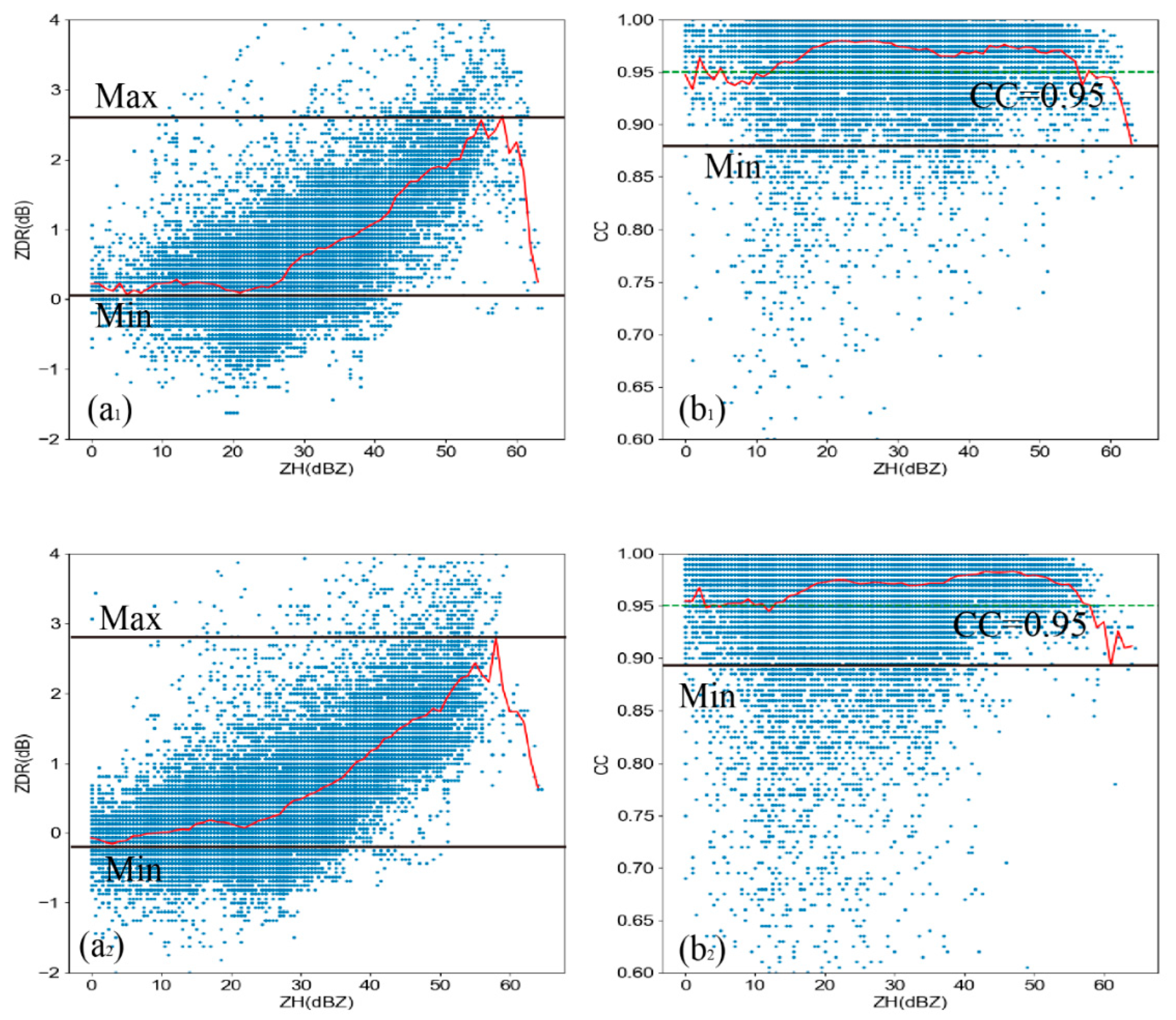
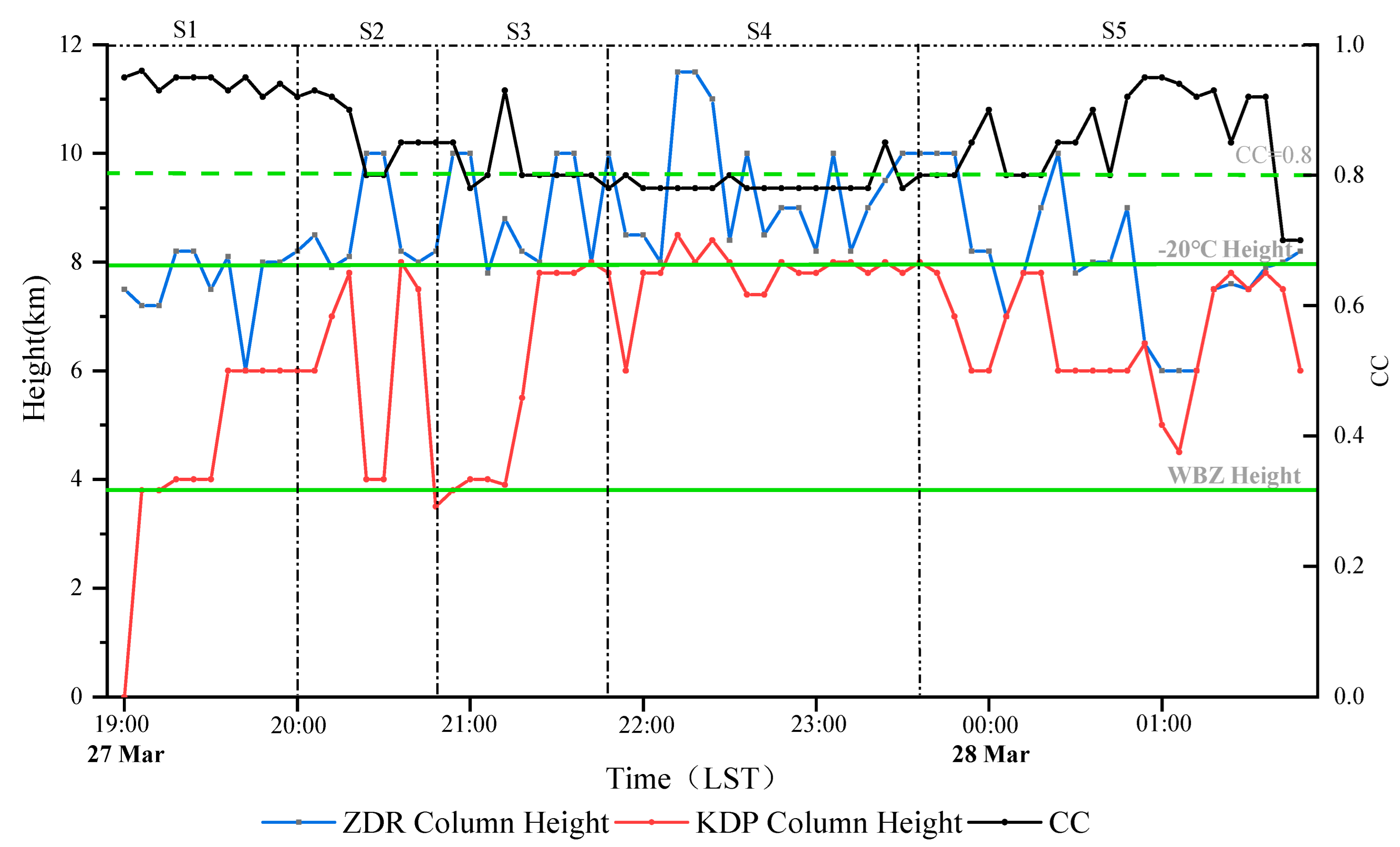
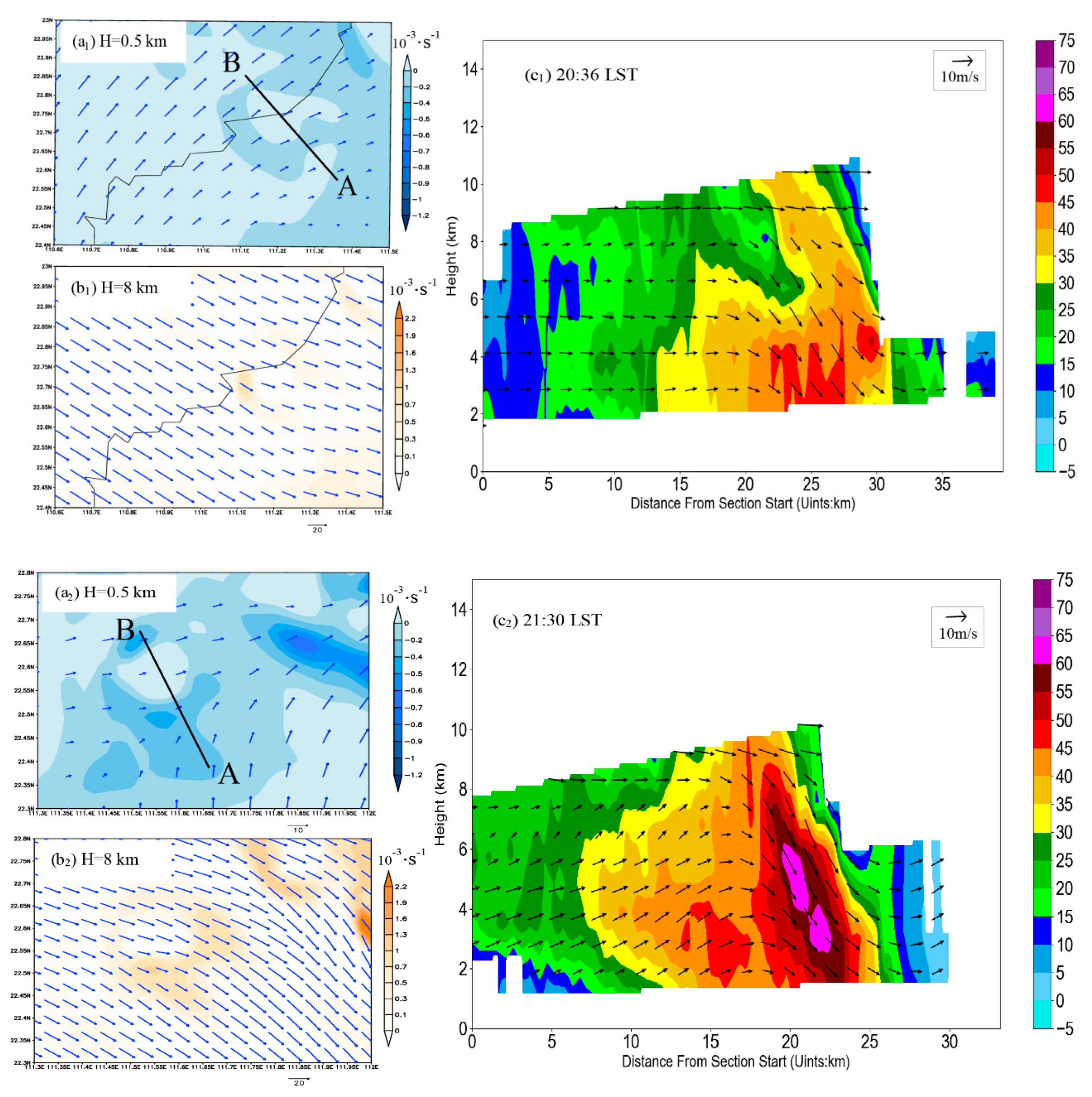


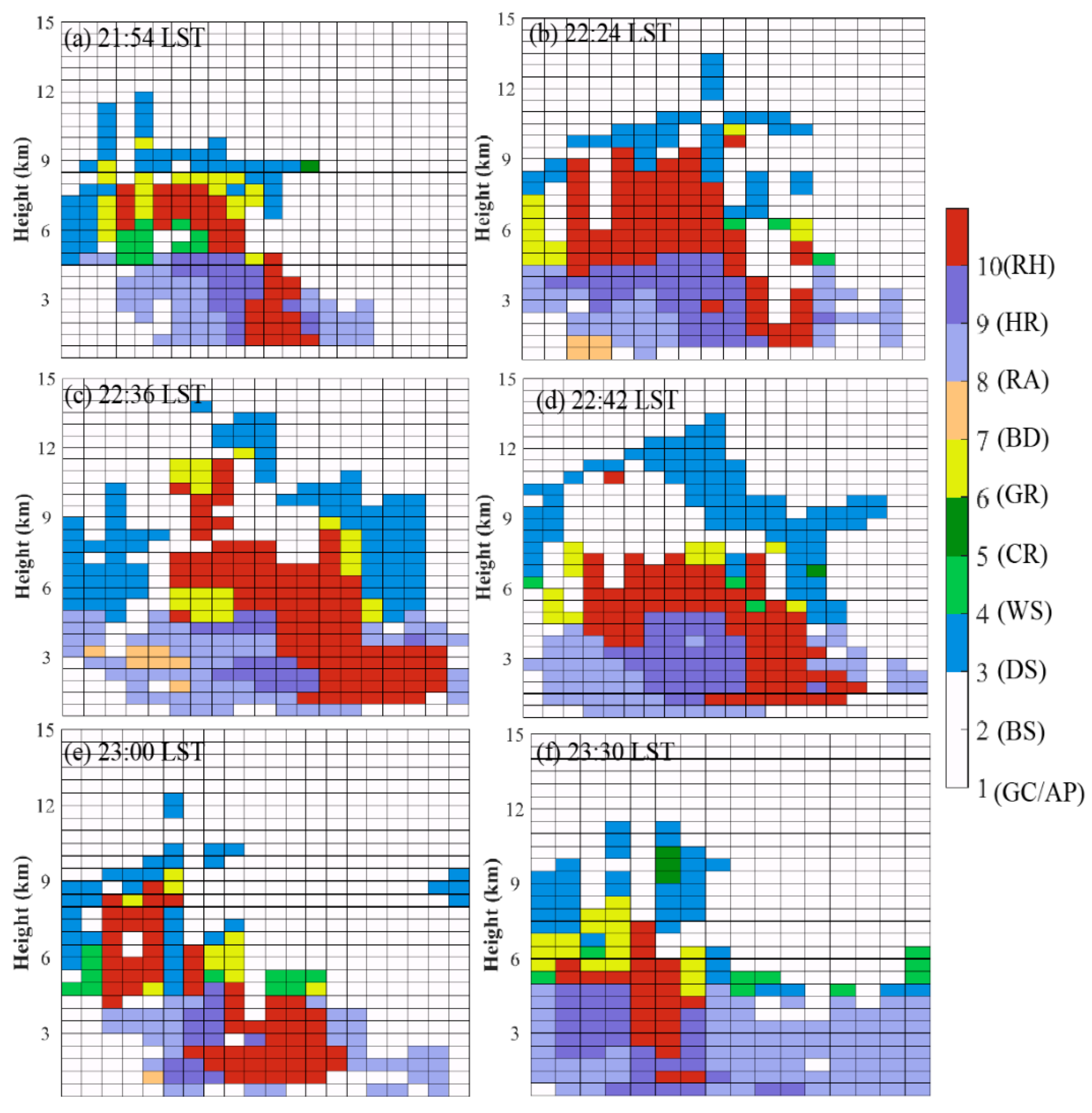
| NO. | Main Variables | Accuracy |
|---|---|---|
| 1 | Wavelength | 10.8 cm |
| 2 | Beam width | 0.95° |
| 3 | Sea level height | 105.6 m |
| 4 | Radial resolution | 250 m |
| 5 | Differential reflectivity factor (ZDR) | ≤0.2 dB |
| 6 | Differential phase (ΦDP), | ≤2° |
| 7 | Specific differential phase (KDP), | ≤0.2°/km |
| 8 | Correlation coefficient (CC) | ≤0.001 |
Publisher’s Note: MDPI stays neutral with regard to jurisdictional claims in published maps and institutional affiliations. |
© 2022 by the authors. Licensee MDPI, Basel, Switzerland. This article is an open access article distributed under the terms and conditions of the Creative Commons Attribution (CC BY) license (https://creativecommons.org/licenses/by/4.0/).
Share and Cite
Zhang, H.; Rao, X.; Guo, Z.; Liu, X.; Yu, X.; Chen, X.; Li, H.; Zhang, J.; Zeng, G.; Chen, S. Detailed Evolution Characteristics of an Inclined Structure Hailstorm Observed by Polarimetric Radar over the South China Coast. Atmosphere 2022, 13, 1564. https://doi.org/10.3390/atmos13101564
Zhang H, Rao X, Guo Z, Liu X, Yu X, Chen X, Li H, Zhang J, Zeng G, Chen S. Detailed Evolution Characteristics of an Inclined Structure Hailstorm Observed by Polarimetric Radar over the South China Coast. Atmosphere. 2022; 13(10):1564. https://doi.org/10.3390/atmos13101564
Chicago/Turabian StyleZhang, Honghao, Xiaona Rao, Zeyong Guo, Xiantong Liu, Xiaoding Yu, Xingdeng Chen, Huiqi Li, Jingjing Zhang, Guangyu Zeng, and Shidong Chen. 2022. "Detailed Evolution Characteristics of an Inclined Structure Hailstorm Observed by Polarimetric Radar over the South China Coast" Atmosphere 13, no. 10: 1564. https://doi.org/10.3390/atmos13101564
APA StyleZhang, H., Rao, X., Guo, Z., Liu, X., Yu, X., Chen, X., Li, H., Zhang, J., Zeng, G., & Chen, S. (2022). Detailed Evolution Characteristics of an Inclined Structure Hailstorm Observed by Polarimetric Radar over the South China Coast. Atmosphere, 13(10), 1564. https://doi.org/10.3390/atmos13101564








